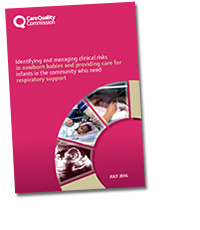This review looked at how risks for newborn babies are identified and managed and at the care for infants in the community who need respiratory support.

Newborn babies may need extra care in a neonatal intensive care unit or special care baby unit if they were born prematurely or if they need care for a particular health condition. Babies and infants that need long-term care can be transferred to a local unit or discharged to receive care at home. A baby with complex health needs may move between distinct areas of care or 'pathways'.
For this review, we have focused on the quality and variability of NHS care, to help us identify if there are gaps that need to be addressed. By doing this, we aim to identify opportunities for improvement and influence the development of clear national guidelines.
What we did
- We visited 19 NHS acute hospital trusts to speak to their staff. In some cases we also reviewed clinical guidance documents.
- We analysed feedback from 16 clinical commissioning groups and eight long-term ventilation network leads.
- We spoke to 10 parents or guardians of children with respiratory support needs, who belonged to long-term ventilation networks.
What we found
Our review focused on three aspects of care. We found variability and inconsistent practice in each.
1. Detecting fetal anomalies and handing over care for babies with a suspected or known fetal anomaly between antenatal, obstetric and neonatal services
- There's a need for clarity about what happens when anomalies are detected that aren't among the 11 screened for as part of the NHS Fetal Anomaly Screening Programme.
- The national guidance on handling fetal abnormalities and transition between specialist teams is insufficient, which gives rise to a risk of inconsistency.
- There is no consistent process of transferring data from the mother's notes to the baby's notes.
- Hospital staff use different methods to communicate information about the fetus.
2. Identifying and managing the care of newborn babies whose condition could deteriorate (with a focus on diagnosing and managing hypertension)
- There's inconsistency in the way early warning tools and triggers are used (such as the Newborn Early Warning Trigger and Track (NEWTT)).
- We saw a risk that high blood pressure (hypertension) in newborn babies could be overlooked and that the frequency of measuring a baby's blood pressure is not mandated.
- There are no national guidelines on how to identify hypertension in babies and children.
3. Managing care for infants in the community who need respiratory support (with a focus on managing respiratory support technologies, including tracheostomies)
- Specialist respiratory support and advice aren't always available to families 24 hours a day, seven days a week.
- Some families said they lacked confidence in care agencies and agency care staff.
- There's variability across CCGs and providers in a number of areas: expected timescales for discharge from hospital to home, the information that is shared and who it's shared with, the frequency of multi-disciplinary team meetings and reviews of home care packages, and the processes to receive feedback from parents or carers.